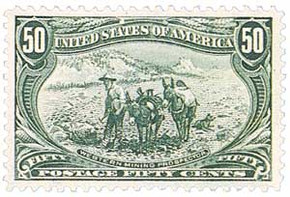
U.S. #287
1898 4¢ Trans-Mississippi Exposition
First Day of Issue: June 17, 1898
Quantity Issued: 4,924,500
Printed by: Bureau of Engraving and Printing
Method: Flat plate
Watermark: Double line USPS
Perforation: 12
Color: Orange
The design of the 4¢ Trans-Mississippi stamp was taken from an engraving by Captain Seth Eastman, a soldier who used his considerable artistic skills to capture scenes from the Old West.
Eastman was born in Maine. His father had hoped to educate his son at Bowdoin College, where Seth would have been a classmate of Henry Wadsworth Longfellow and Nathaniel Hawthorne. But Seth had other ideas, and attended West Point before his assignment to Fort Snelling, the country’s northernmost frontier post. Fort Snelling has been described as “an extravagant display of American sovereignty that would never be equaled in the two thousand miles that stretched west of the Mississippi.” While stationed there, the soldier-artist amassed a portfolio of paintings devoted to the study of “Indian character, and the portraying upon canvas of their manners and customs, and the more important fragments of their history.”
The Bureau of Engraving and Printing’s designer and engraver eliminated background figures in Eastman’s original painting and focused only on the racing Indian and buffalo.
The 4¢ stamp features the same border as the rest of the values. Unlike the 1893 Columbian series, the Trans-Mississippi Exposition commemoratives didn’t include the name or dates of the event. Instead, each stamp features a caption with the name of the photograph or painting upon which its design is based.
Printed by the Bureau of Engraving and Printing
The Trans-Mississippi commemorative stamps were printed by the Bureau of Engraving and Printing. Original plans called for the series to be printed in bi-color. However, the Spanish-American War strained the resources of the Bureau of Engraving and Printing, which was overburdened by the demand for revenue stamps to fund the war. The Trans-Mississippi commemoratives were printed in a single color, with the 4¢ denomination printed in orange ink. The ink was subject to oxidation, causing the stamps to turn various shades of orange over the years.
About the 1898 Trans-Mississippi Exposition Series
The 1898 Trans-Mississippi and International Exposition was held to further the progress and development of natural resources west of the Mississippi River. Held in Omaha, Nebraska, the exposition opened on June 1, 1898, and ran for four months. More than 4,000 exhibits showcased social, economic, and industrial resources of the American West. The expo wasn’t a financial success overall, but it did revitalize Omaha, a community that had been devastated by drought and depression.
Over 2.6 million people attended the expo, which featured the Indian Congress, the largest Native American gathering of its kind. Over 500 members representing 28 tribes camped on the fairgrounds and introduced Americans from the East to their way of life. Reenactments of the explosion of the battleship Maine also fueled patriotism and support for the Spanish-American War.
The series is also referred to as the “Omahas” because the show was held in the city of Omaha. An unknown number of unsold stamps were recalled and destroyed.















